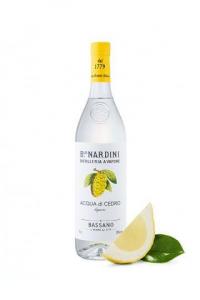Manufacturer > Ditta Bortolo Nardini

Ditta Bortolo Nardini
This is a story that began long ago, in 1779 to be exact, in Bassano del Grappa, the heart of the Veneto Region of Italy, at the gateway to the covered bridge known as Ponte Vecchio, designed by Andrea Palladio.
At that time, the city was a strategic commercial center at the crossroads from the Valsugana, Valley towards Venice, a thoroughfare for commerce connecting la Serenissima Republic of Venice with the Trentino Region and Austria. Further north, in the Cembra Valley, the art of distillation was widespread. This was the birthplace of Bortolo Nardini, forefather of what is now the oldest and most long-lived family of Italian distillers. Bortolo left his town with tenacity and vision, purchasing in 1779 “Osteria al Ponte”, tavern on the bridge, which was to become the home of the Nardini Distillery in Bassano. This was a medieval structure on the eastern bank of the Brenta river with an unrivalled location for commerce. Here Bortolo Nardini distilled his grappa, and the story of the Nardini Distillery began. The foothills of the Veneto plain that surround Bassano assure the distillery a constant supply of grape pomace, the raw material for grappa production, collected in September and October after the grape harvest and pressing for wine took place.
From the end of the 1700s to the early 1800s distillation occurred by utilizing the traditional stills and the distillate was stored in copper vats. Bortolo Nardini labeled his grappa “Aquavite di vinaccia”, spelling acquavite in the Latin style, without the letter “c”, as in fashion at that time, and using the play on the word acquavite meaning both distillate and water of life.
With the succeeding generations the distillery’s activity expanded, creating notoriety far beyond local borders. Before long the Nardini Distillery had built a reputation as one of the finest commercial and entrepreneurial activities of their time, dedicated to preserving their know-how and passing it on from generation to generation. The goals that Nardini has achieved over time, such as innovative distillation techniques, are fruit of its heritage based on values intrinsic to the history of the Nardini family. Values inspired by a strong work ethic, the constant search for excellence and social responsibility, tenets that are cherished to this day by the company. The long Nardini tradition is preserved through their products and has become a symbol of their homeland. Marked by a constant quest for perfection and artisanal culture, their legacy of over two centuries is conserved within each of the millions of bottles of grappa exported around the world.
Since the beginning, the Grapperia on the bridge was a bar and point of sale; commercial barges and rafts transporting wood and cargo crowded the banks of the river Brenta allowing “Aquavite Nardini” to be known in every corner of the Venetian Republic. In the second half of the 1800s, the steam method of distillation was introduced, replacing the direct flame method. The use of steam guaranteed a constant temperature during distillation, resulting in a better quality and uniformity of the final product. At this time, the Nardini Distillery increased its assortment of products to include the production of many liqueurs such as Tagliatella, Acqua di Cedro, Mistrà and Fernet.
In the beginning of the 20th Century, Ditta Bortolo Nardini was the most famous grappa distillery in Italy. With the outbreak of World War I and the movement of the front to the territory enclosed between Mount Grappa and the Piave River, Nardini witnessed the dramatic scenes of the global conflict. During the war, grappa was a form of comfort; soldiers brought it to the front lines to warm them on long nights in the trenches and it helped them keep the faith when all seemed lost. In the post-war period, grappa steadily gained great popularity and became the Italian national distillate.
At the end of the Second World War, the devastated bridge was rebuilt and the Nardini family enthusiastically reorganized their business: for the first time “Riserva” grappa was introduced, aged in Slavonian oak barrels, it was a welcome addition to the traditional Nardini clear grappa. Nardini adopted the tradition of amber distillates and perfected the secrets of barrel aging to hone the production method of this prized grappa. At the same time, the liqueur lines gain popularity, especially Tagliatella, a product with interesting origins. The name comes from the word “tagliare”, meaning to cut, derived from the mixture, or “cut”, of various products that were once served straight from copper vats. In the years of economic resurgence, the consumption of grappa outside the home grew steadily as well as a burgeoning number of aficionados. Ditta Bortolo Nardini continued to develop on two fronts: investing on constantly improving and innovating their distillation methods and passing on the jealously guarded secrets of the family business. Ditta Bortolo Nardini is headed today by the seventh generation: Cristina and cousins Angelo, Antonio and Leonardo Nardini who are in charge of the key sectors of the business.
In recent years, the legacy of Nardini was recognized: the company became part of the exclusive international association “Les Hénokiens”, uniting family companies from all over the world that are over 200 years old. The Grapperia, unchanged since 1779, is part of the prestigious organization Historical Places of Italy. In 2004 Ditta Bortolo Nardini celebrated its 225th anniversary with the inauguration of Bolle and the presentation of an exceptional distillate: “Aquavite di Vinaccia Riserva 15 Anni”, a special grappa, aged in wood for a full 15 years, the latest addition to the Nardini product portfolio.
Bolle is a futuristic architectural work that was strongly desired by the family and commissioned to the Italian architect Massimiliano Fuksas. The modern multipurpose structure also houses an auditorium to welcome the growing number of tourists and aficionados of grappa. Numerous international cultural events sponsored by Nardini are held at Bolle. Ditta Bortolo Nardini is a key corporate sponsor of the Peggy Guggenheim Collection of Venice, consolidating their strong ties to art and culture. They also support the other outlets of contemporary art such as the dance project for CSC, Center for the Contemporary Scene, and Infart, the festival dedicated to urban culture and street art, in the belief that a company should contribute to the enhancement of the territory and its most significant expressions.
“There are names that, due to their history, remain powerfully linked to an experience and become an inseparable icon of a place, a product, an entire culture”.
Headquarters
 , Italy
, Italy
Website

Facts and figures






Since 1779
 246 years in 2025
246 years in 2025
Company details
Activity

Distribution channels

Certifications

Clients

Production capacity

Logistic capabilities

Minimum Order Quantities

 Countries of activity
Countries of activity14 products
View more products




